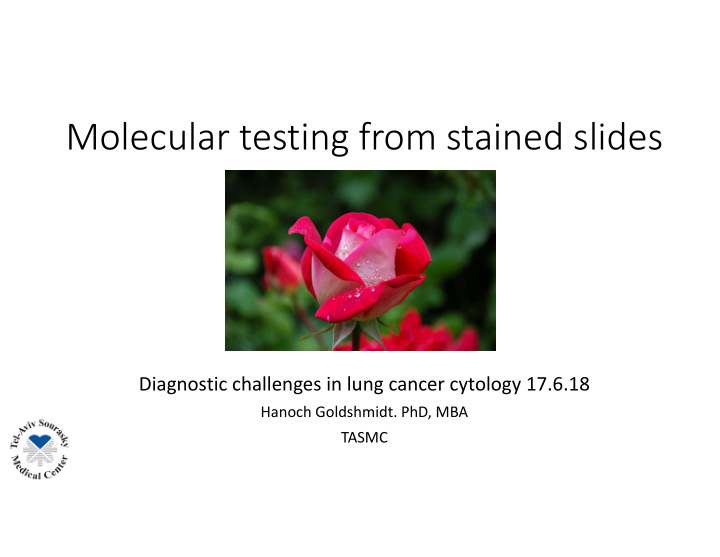



Molecular testing from stained slides Diagnostic challenges in lung cancer cytology 17.6.18 Hanoch Goldshmidt. PhD, MBA TASMC
WHAT IS ROSE? • Rapid on‐site evaluation, or ROSE, is a service that pathologists and cytotechnologists commonly perform to check the cellular content and adequacy of fine‐needle aspiration smears and biopsy touch imprints • What for? • inform the operator of the need to obtain additional samples and avoid having to repeat the procedure • Preliminary diagnosis so that additional material can be requested
EBUS ‐ endobronchial US
CT‐guided
TASMC ROSE PROCEDURE: Prepare the instruments
Prepare the slides
DRY and stain using Romanowsky Quik Diff protocol
Diagnose and discuss with physician if another biopsy is needed. Save slides for further molecular tests
ROSE during CT‐guided CNB / FNA
• “good purity of tumor DNA in cytology FNA samples when compared with biopsy samples” • “DNA extracted from EBUS sourced cases (n =50) gave on average twice the amount of DNA as that extracted from FFPE (n =325) (16 vs.8 ug total DNA, measured using Nanodrop)” • “DNA from FFPE required 1.6 amplicon repeats per patient to obtain a result whereas DNA from EBUS cytofluid material required 0.46 amplicon repeats per patient” Stevensont et al. Diagnostic Cytopathology. 2018;1–7
Stevensont et al. Diagnostic Cytopathology. 2018;1–7
• “When paraffin‐embedded tissue is used for molecular testing of lung cancer, CNB specimens are more likely than FNA specimens to provide adequate tissue for molecular testing. • Obtaining a sufficient FNA specimen depends on the tumor size and the individual performing the biopsy”
“During the study period, FNA samples were consistently more adequate for molecular testing than CT‐guided NCB samples, as seen in Tables 2 and 3, unlike the study by Schneider et al.” “Many variables are likely to play a role, including type of lesion; operator experience and the material itself” Arch Pathol Lab Med—Vol 141, March 2017
Using cytology samples for molecular diagnosis TASMC 2018 ‐ Cases that we extracted cytology and FFPE DNA samples Sample types usage ? ? 14 12 10 8 6 4 2 0 RTPCR NGS CELL BLOCK CYTOLOGY FFPE
DNA concentration and Quality Cytology concentration FFPE (ng/ul) concentration(ng/ul) Quantity median 7.5 35.5 dsDNA/total extraction DNA rate ng/ul-qubit nanodrop-ng/ul sample date 40% 17.20 43 c17-03699 5.12.17 4% 0.08 2 c18-01233 25.3.18 Quality 5% 0.48 9 c18-09185 7.5.18 17% 8.35 49 18-02045-1 12.3.18 43% 9.92 23.3 18-06799 20.3.18 14% 4.03 29 18-00468 26.2.18 • Data from cases with FFPE tissue + cytology
conclusion • Rapid onsite evaluation is a service that prevents repeating procedures • Rapid onsite evaluation provides suitable material for molecular testing including NGS and RT‐PCR. • When lung cancer material becomes so crucial for so many tests, we should have good procedures to utilize all the available samples, including cytology smears • Factors to consider: • amount of material • Percentage of tumor cells • quality of DNA from these samples
THANKS • Prof. Dov Hershkovitz • Dr. Irit Solar • Mr. Pavel Gurianov • Mrs. Lital Tayblum • Mrs.Ziva Ahron
Recommend
More recommend